|
Grumman
F6F-3 Hellcat
by
Arlo Schroeder
|
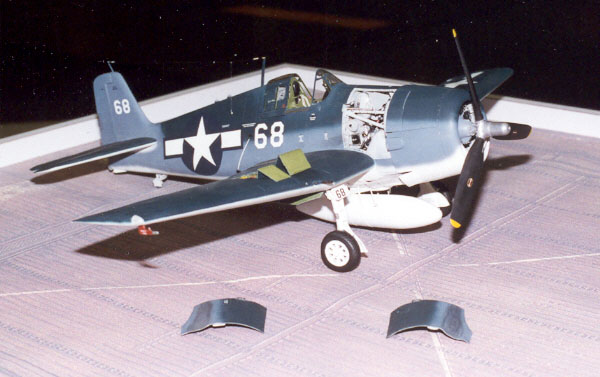
|
|
Scratchbuilt 1/16th
Scale Grumman F6F-3 Hellcat |
Text
by Ben Backes

HyperScale is proudly sponsored by Squadron
Arlo Schroeder, a former Boeing Wichita employee, spends a good
portion of his retirement scratchbuilding 1/16 models in his basement
workshop. Many aspects of this model operate, just like the real thing.
As you can see from this article his models are amazing.
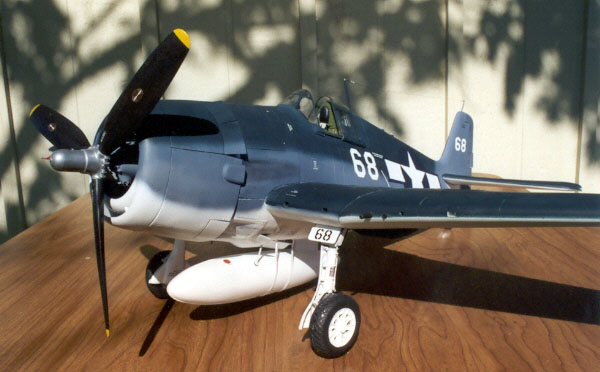
This model depicts an F6F-3 of VF-10 from the USS Enterprise (CV-6)
as flown by Lt JG Jay Shinneman during the famous Mariannas Turkey shoot
of June 20th 1944.
Construction
Photo Feature
|
Click the thumbnails below to view
the images full-sized.
Use the "Back" arrow of your browser to return to this page.
The completed model currently on display at the Naval Aviation Museum
in Pensacola, Florida.
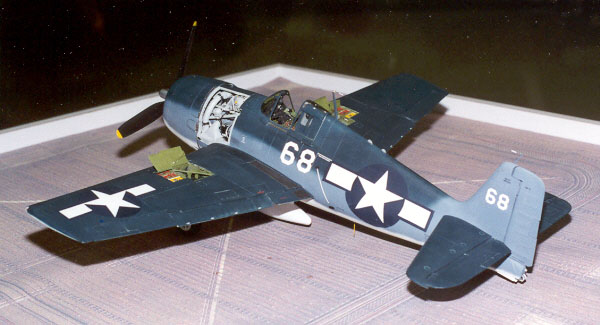
Photo 3
Every model starts somewhere and this one started with the wing
center section, with landing gear and wing attachments.

Photos 4 & 5
Yep, the landing gear actually works. Here you see it rotate into the
raised position.


Photo 6
The major fuselage, wing and tail surfaces are vacuum-formed on a
table built right into the workbench. This photo shows the form for the
left rear fuselage piece. The form is carved from balsa using templates
at each reference line. When the shape is right Arlo coats the wood with
super glue to harden it and sands it out smooth then vacuum-forms the
pieces.

Photo 7
The wing center section and the beginnings of the cockpit area and
rear fuselage interior.

Photo 8
Building up the rear interior.

Photo 9
The firewall.
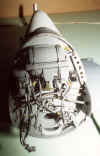
Photo 10
Engine crankcase and intercooler

Photo 11
Just how big is a 1/16th scale Hellcat anyway? Well… it's twice as
big as this Hasegawa 1/32nd kit sitting in front of it.

Photo 12
Six Browning .50 caliber machine guns made from brass.

Photo 13
The left outer wing, gun bay, and flaps. The control surfaces work,
so do the flaps, and the ammo bay covers.

Photo 14
Stabs and elevators.

Photo 15
Interior of the stabs.

Photo 16
Look at those tiny operating piano hinges.

Photo 17
And here's what the underside looks like.

Photo 18
Crankcase and engine mount
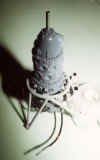
Photo 19
Engine components before assembly with an American dime thrown in for
size reference. A master for one cylinder from each row was built using
disks of .005 inch thick aluminum for the cooling fins stacked up in
alternating sizes. Then a rubber mold was made and resin copies were
cast.

Photo 20
The completed engine.

Photo 21
Wing folding mechanism.

Photo 22
A rotating jig was made to aid in scribing the fuselage panel lines.

Photo 23
When Bob Waldron heard about the project he scaled up his placard set
for Arlo.

Photo 24
The completed cockpit just before the windscreen was attached.

Photo 25
For the canopy, Arlo started out carving a balsa form. Then he used
plaster to make a female mold of the shape. The next step was to make a
resin version of the form that was much easier to smooth and polish.
Then the canopy was then vacuum-formed.

Photo 26
Strips of dry-transfer rivets provided by Archer Fine Transfers are
taped into place and ready to be rubbed on. The windscreen is attached
and blended in. The track for the sliding portion of the canopy is also
attached.

Photo 27
Model Master Enamels were used for painting and the markings were
custom-made dry transfers by Woody Vondracek of Archer Fine Transfers.

Photo 28
The tailhook in the extended position.

Photo 29
Out back behind the house the completed model with the cowling
removed, the wings folded and the gun bays open.

The model took about 3600 hours to build over a two year time period.
Arlo's favorite era to model is pre-WWII and for the last few months
I've been watching him finish up a Curtiss SBC-4 Helldiver.
In 1/16th scale he has also built a Boeing F4B-2, Grumman F2F-1,
Curtiss BFC-2, Brewster F2A-2 Buffalo, Boeing P26-A Peashooter, Douglas
TBD-1 Devastator, Curtiss SOC-3 Seagull with catapult (also at the Naval
Aviation Museum), and finally a Grumman TBF-1C Avenger (on display in
the National Air and Space Museum.) Before going to 1/16th scale, Arlo
scratchbuilt in 1/32nd scale a TBF-1C, Vought SB2U-1 Vindicator, and a
couple of big flying boats, the Consolidated P2Y-2 and a Martin PBM-5A
Mariner.
So what's up next on his workbench? A Grumman F8F Bearcat.
If you want to see more, send me an e-mail with your vote for which
one!
Model and Images Copyright ©
2001 by Arlo Schroeder
Text Copyright ©
2001 by Ben Backes
Page Created 09 May, 2001
Last Updated 04 June, 2007
Back to HyperScale
Main Page
Back to Features Index
|
Home
| What's New |
Features |
Gallery |
Reviews |
Reference |
Forum |
Search